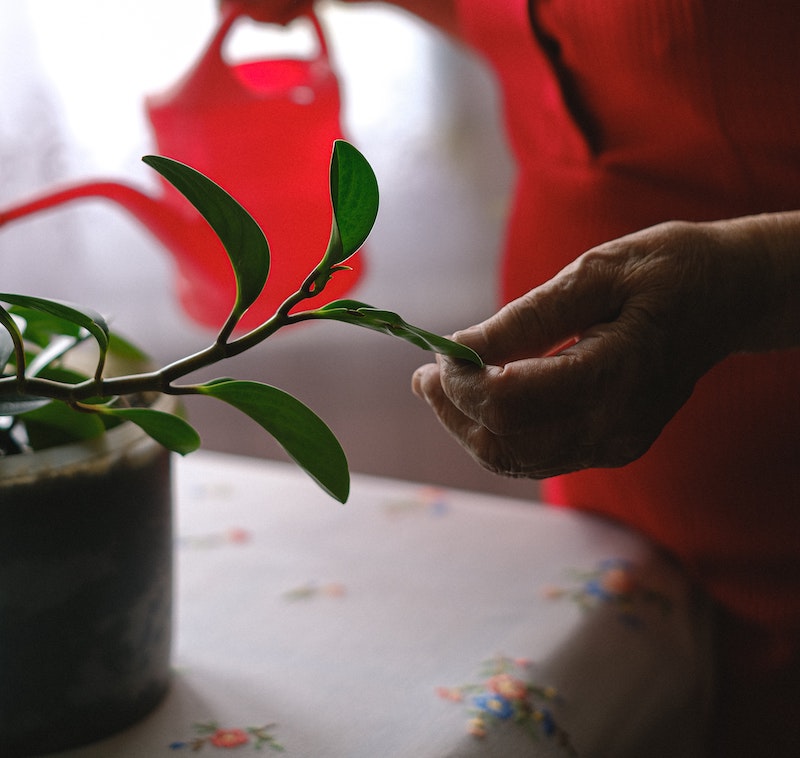Hoya is a very large genus of plants that has upwards of 500 varieties and numerous cultivars available to grow as houseplants. These tropical plants are epiphytes that grow either attached to other host plants or in very loose and shallow soils. Even though Hoya can naturally gather moisture and nutrients from the air, home growing conditions are very different from this plant’s native environment. The native regions of East Asia and Australia are tropical climates with high humidity and moderate warmth.

How To Tell If Hoya Needs Water
Although Hoyas strongly resemble succulents with their thick fleshy leaves, this houseplant is closely related to the Dogbane family of plants and requires regular and controlled watering to thrive indoors. Under-watering Hoya is much less of a problem than over-watering, although both will cause the death of the plant after an extended period. Under-watered Hoyas will have a limp appearance to their leaves, which may wrinkle, shrivel and eventually fall off the stem. The stems will turn brown and begin to die back from the tips. Reviving an under-watered plant is not difficult and should be done as soon as the problem is noticed. Place the plant, still in the pot, either in the sink or if needed, a bathtub. Give the plant an extra deep watering, fully rehydrating the potting medium and washing any dust or dirt from the leaves. Letting the plant sit in a few inches of water for up to 30 minutes will also help the potting medium to rehydrate fully. Let the plant drain and return it to its growing position. Misting with a fine mist sprayer every 2-3 days will help humidity levels stay high around the plant.
Over-watered plants tend to turn yellow with brown or black on the petiole, or stem of the leaf. Continued over-watering will result in the roots rotting and the whole plant dying. The best way to avoid this situation is to start with a fast-draining potting mix that contains fine orchid bark mixed at a ratio of 1:1 or use a premixed succulent potting mix. Reviving an overwatered plant can be tricky but is not impossible. If the potting mix is free draining, cut back on the frequency of watering and your Hoya is likely to rebound quickly. Repotting into lighter soil is also an option for reviving a drowning plant. When you remove the plant from the old pot, inspect the roots for brown or black color, or mushiness. Cut those roots out and repot the Hoya.
Overwatering is more likely to happen during the winter months when the plant dramatically slows growth and goes semi-dormant. Watering can be reduced to once a month as long as the humidity level remains high. Using a fine mist sprayer, cool mist humidifier, or a humidity tray may be needed. Growing many plants together in one room allows them to transpire together during the night, making the room naturally higher in humidity.

How To Water Hoya
Hoyas require a consistent watering schedule, which will change with the seasons. Watering during spring through early fall, while the plant is actively growing, should be done once every 7-10 days, depending on heat and humidity levels. Hoya growing in higher heat and drier locations will need more frequent watering. During the growing season, only allow the top one-third of the potting mix to dry in between waterings. Water with either filtered water, rainwater, or tap water that has been left to sit for 24 hours. This allows any chlorine to dissipate before use. Water the plant enough that the water runs from the drainage holes on the bottom of the pot. Make sure to empty pot saucers of excess water so that the roots do not sit in water and develop rot.
Hoya will require far less watering during the winter. Allow the top half of the potting mix to dry between waterings while continuing to provide high humidity with daily misting or other methods. It is not unusual for Hoyas to be able to go for a month or more between waterings during this semi-dormant period.
Hoya Watering Tips
- Hoya are epiphytic plants that require high humidity year-round
- Allow the top one-third of the soil to dry between waterings in the summer
- Plants in brighter and hotter conditions will need watering more often during the growing season
- Plants grown in cooler and shadier conditions run the risk of being overwatered
- Use water that is free from chlorine such as filtered water or rainwater
- Let tap water sit for 24 hours before using it on Hoyas
 |
Author Robbin Small - Published 04-04-2023 |
